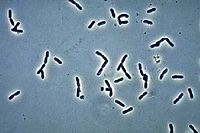Revision as of 13:38, 15 April 2009 by imported>Julie Evans
| Pseudomonas putida
|

|
| Scientific classification
|
| Kingdom:
|
Eubacteria
|
| Phylum:
|
Proteobacteria
|
| Class:
|
Gamma Proteobacteria
|
| Order:
|
Pseudomonadales
|
| Family:
|
Pseudomonadaceae
|
| Genus:
|
Pseudomonas
|
| Species:
|
putida
|
|
| Binomial name
|
Pseudomonas putida
|
Lactococcus Lactis" is a non pathogenic,Gram-positive bacteria known as one of the most important microbes in dairy food production. Lactococci are immotile, nonsporelating, and are usually spherical or ovoid cells. Lactococci group in pairs or short chains with a length of about 1.2µm by 1.5µm. L. Lactis is usually found in milk and is the starter culture for the production of fermented dairy products such as cheese and yogurt. Lactococcus is considered a oportunistic pathogen because of its ability to produce lactic acid. Lactic acid produced by the the microbe curdles the milk which seperates into curds, inturn are used to produce cheese and whey.The lactic acid produced by the bacterium also lowers the pH of the product and preserves it from the growth by unwanted bacteria and molds, meanwhile other metabolic products and enzymes produced by Lactococcus lactis are responsible for the aromas and flavors of other distinguishable cheeses. Lactococcus lactis has two subspecies, Lactococcus lactis subsp. lactis and subsp. cremoris, both are used in cheese production.These organisms were originally classified under the genus Streptococcus, but in 1985, it was assigned to the current genus
Description and signifigance
Genome structure
Cell structure and metabolism
Ecology
Pathology
Application to Biotechnology
Current Research
References
New section
